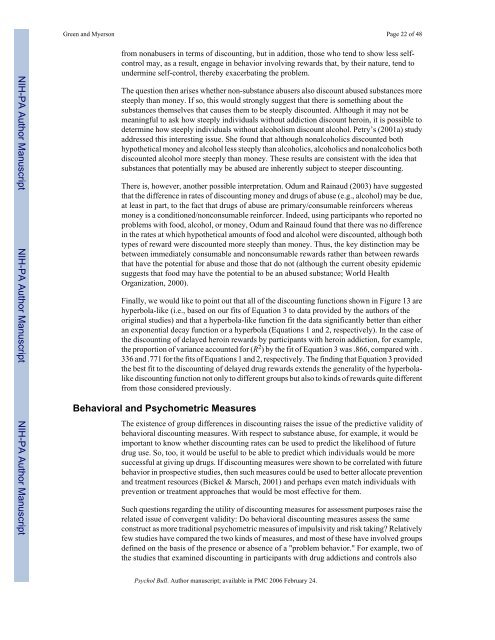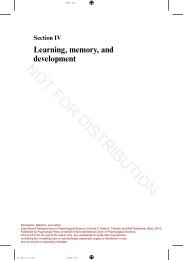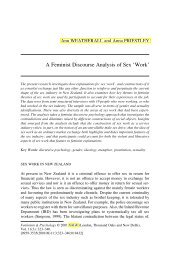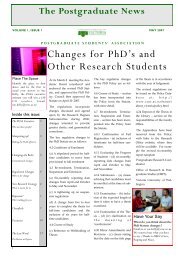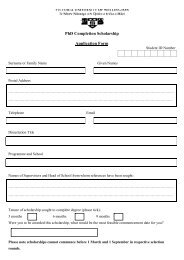green & myerson 2004.. - of /courses
green & myerson 2004.. - of /courses
green & myerson 2004.. - of /courses
Create successful ePaper yourself
Turn your PDF publications into a flip-book with our unique Google optimized e-Paper software.
Green and Myerson Page 22 <strong>of</strong> 48<br />
NIH-PA Author Manuscript NIH-PA Author Manuscript NIH-PA Author Manuscript<br />
from nonabusers in terms <strong>of</strong> discounting, but in addition, those who tend to show less selfcontrol<br />
may, as a result, engage in behavior involving rewards that, by their nature, tend to<br />
undermine self-control, thereby exacerbating the problem.<br />
The question then arises whether non-substance abusers also discount abused substances more<br />
steeply than money. If so, this would strongly suggest that there is something about the<br />
substances themselves that causes them to be steeply discounted. Although it may not be<br />
meaningful to ask how steeply individuals without addiction discount heroin, it is possible to<br />
determine how steeply individuals without alcoholism discount alcohol. Petry’s (2001a) study<br />
addressed this interesting issue. She found that although nonalcoholics discounted both<br />
hypothetical money and alcohol less steeply than alcoholics, alcoholics and nonalcoholics both<br />
discounted alcohol more steeply than money. These results are consistent with the idea that<br />
substances that potentially may be abused are inherently subject to steeper discounting.<br />
There is, however, another possible interpretation. Odum and Rainaud (2003) have suggested<br />
that the difference in rates <strong>of</strong> discounting money and drugs <strong>of</strong> abuse (e.g., alcohol) may be due,<br />
at least in part, to the fact that drugs <strong>of</strong> abuse are primary/consumable reinforcers whereas<br />
money is a conditioned/nonconsumable reinforcer. Indeed, using participants who reported no<br />
problems with food, alcohol, or money, Odum and Rainaud found that there was no difference<br />
in the rates at which hypothetical amounts <strong>of</strong> food and alcohol were discounted, although both<br />
types <strong>of</strong> reward were discounted more steeply than money. Thus, the key distinction may be<br />
between immediately consumable and nonconsumable rewards rather than between rewards<br />
that have the potential for abuse and those that do not (although the current obesity epidemic<br />
suggests that food may have the potential to be an abused substance; World Health<br />
Organization, 2000).<br />
Finally, we would like to point out that all <strong>of</strong> the discounting functions shown in Figure 13 are<br />
hyperbola-like (i.e., based on our fits <strong>of</strong> Equation 3 to data provided by the authors <strong>of</strong> the<br />
original studies) and that a hyperbola-like function fit the data significantly better than either<br />
an exponential decay function or a hyperbola (Equations 1 and 2, respectively). In the case <strong>of</strong><br />
the discounting <strong>of</strong> delayed heroin rewards by participants with heroin addiction, for example,<br />
the proportion <strong>of</strong> variance accounted for (R 2 ) by the fit <strong>of</strong> Equation 3 was .866, compared with .<br />
336 and .771 for the fits <strong>of</strong> Equations 1 and 2, respectively. The finding that Equation 3 provided<br />
the best fit to the discounting <strong>of</strong> delayed drug rewards extends the generality <strong>of</strong> the hyperbolalike<br />
discounting function not only to different groups but also to kinds <strong>of</strong> rewards quite different<br />
from those considered previously.<br />
Behavioral and Psychometric Measures<br />
The existence <strong>of</strong> group differences in discounting raises the issue <strong>of</strong> the predictive validity <strong>of</strong><br />
behavioral discounting measures. With respect to substance abuse, for example, it would be<br />
important to know whether discounting rates can be used to predict the likelihood <strong>of</strong> future<br />
drug use. So, too, it would be useful to be able to predict which individuals would be more<br />
successful at giving up drugs. If discounting measures were shown to be correlated with future<br />
behavior in prospective studies, then such measures could be used to better allocate prevention<br />
and treatment resources (Bickel & Marsch, 2001) and perhaps even match individuals with<br />
prevention or treatment approaches that would be most effective for them.<br />
Such questions regarding the utility <strong>of</strong> discounting measures for assessment purposes raise the<br />
related issue <strong>of</strong> convergent validity: Do behavioral discounting measures assess the same<br />
construct as more traditional psychometric measures <strong>of</strong> impulsivity and risk taking? Relatively<br />
few studies have compared the two kinds <strong>of</strong> measures, and most <strong>of</strong> these have involved groups<br />
defined on the basis <strong>of</strong> the presence or absence <strong>of</strong> a "problem behavior." For example, two <strong>of</strong><br />
the studies that examined discounting in participants with drug addictions and controls also<br />
Psychol Bull. Author manuscript; available in PMC 2006 February 24.


